Hydrothermal synthesis of single-crystal CeCO3OH and their thermal conversion to CeO2
- 格式:pdf
- 大小:1.75 MB
- 文档页数:4
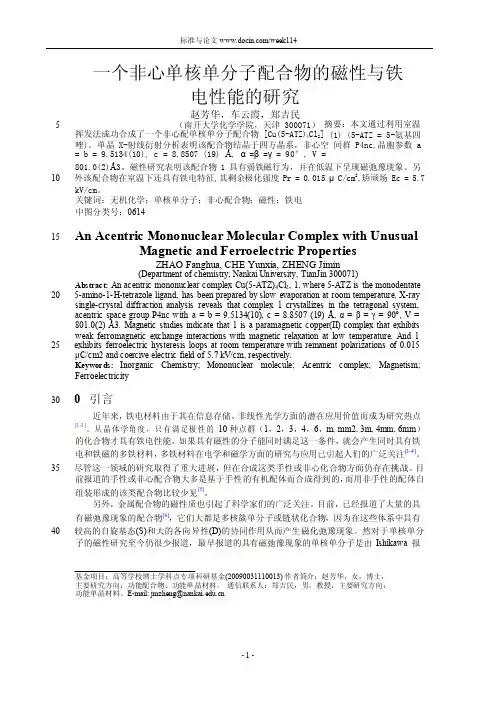
一个非心单核单分子配合物的磁性与铁电性能的研究赵芳华,车云霞,郑吉民5(南开大学化学学院,天津 300071) 摘要:本文通过利用室温挥发法成功合成了一个非心配单核单分子配合物 [Cu(5-ATZ)4Cl 2] (1) (5-ATZ = 5-氨基四唑)。
单晶 X-射线衍射分析表明该配合物结晶于四方晶系,非心空 间群 P4nc,晶胞参数 a = b = 9.5134(10), c = 8.8507 (19) Å, α=β=γ= 90°, V =801.0(2)Å3。
磁性研究表明该配合物 1 具有弱铁磁行为,并在低温下呈现磁弛豫现象。
另 10外该配合物在室温下还具有铁电特征,其剩余极化强度 Pr = 0.015 μC/cm 2,矫顽场 Ec = 5.7 kV/cm 。
关键词:无机化学;单核单分子;非心配合物;磁性;铁电 中图分类号:061415An Acentric Mononuclear Molecular Complex with UnusualMagnetic and Ferroelectric PropertiesZHAO Fanghua, CHE Yunxia, ZHENG Jimin(Department of chemistry, Nankai University, TianJin 300071)Abstract: An acentric mononuclear complex Cu(5-ATZ)4Cl 2, 1, where 5-ATZ is the monodentate 205-amino-1-H-tetrazole ligand, has been prepared by slow evaporation at room temperature. X-ray single-crystal diffraction analysis reveals that complex 1 crystallizes in the tetragonal system, acentric space group P4nc with a = b = 9.5134(10), c = 8.8507 (19) Å, α = β = γ = 90°, V = 801.0(2) Å3. Magnetic studies indicate that 1 is a paramagnetic copper(II) complex that exhibits weak ferromagnetic exchange interactions with magnetic relaxation at low temperature. And 1 25exhibits ferroelectric hysteresis loops at room temperature with remanent polarizations of 0.015 μC/cm2 and coercive electric field of 5.7 kV/cm, respectively.Keywords: Inorganic Chemistry; Mononuclear molecule; Acentric complex; Magnetism; Ferroelectricity300 引言近年来,铁电材料由于其在信息存储、非线性光学方面的潜在应用价值而成为研究热点 [1-2]。
![配合物[Co(H2biim)2(phth)]的水热合成、晶体结构与表征](https://uimg.taocdn.com/71d4b0cfcf2f0066f5335a8102d276a2002960bc.webp)
配合物[Co(H2biim)2(phth)]的水热合成、晶体结构与表征杨莉宁;崔斌;支燕翔;黑佳慧;张逢星【摘要】以2,2’-联咪唑(H2biim)和邻苯二甲酸(H2phth)为配体,以钴为中心离子采用水热方法合成了配合物[Co(H2biim)2(phth)],通过单晶X-射线衍射、红外光谱、紫外光谱、热重分析和元素分析等方法对其进行了晶体结构的解析和表征.晶体属于单斜晶系,P2(1)/n空间群,晶胞参数分别为α=0.849 39(3) nm,b=1.156 45(5) nm,c=2.059 40(10) nm,β=94.769°.V=2.015 90(15) nm3,D=1.619(g/cm3),Z=4.热重分析表明,该配合物在300℃以下稳定.%The complex[Co(H2biim)2(phth) ] was synthesized by hydrothermal method. It was characterized by elemental analysis, IR, UV and TG-DTA, the crystal structure was determined by X-ray diffraction. The results showed that the Co( Ⅱ)complex belongs to monoclinic with space group P2( 1 )/n,a = 0.849 39(3) nm,6 = 1.156 45(5) nm,c =2.059 40(10) um,β =94. 769°, V = 2. 015 90(15) nm3, D=1.619 (g/cm3),Z =4. Thermal gravimetric analysis showed that the complex is stable below 300℃.【期刊名称】《应用化工》【年(卷),期】2012(041)004【总页数】5页(P573-577)【关键词】2,2’-联咪唑;钴配合物;晶体结构;热稳定性【作者】杨莉宁;崔斌;支燕翔;黑佳慧;张逢星【作者单位】西安医学院药学院,陕西西安710021;西北大学化学与科学材料学院,陕西西安710069;西北大学化学与科学材料学院,陕西西安710069;西北大学化学与科学材料学院,陕西西安710069;西北大学化学与科学材料学院,陕西西安710069;西北大学化学与科学材料学院,陕西西安710069【正文语种】中文【中图分类】TQ138.1+2钴是生物学上重要的微量元素,它能在一些酶中代替锌,而不改变原来酶的活性[1],钴的光谱和磁性是酶活性部位的有效探针[2]。
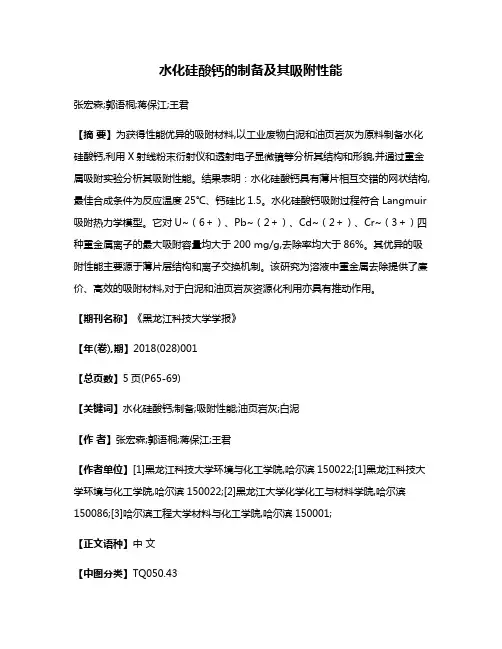
水化硅酸钙的制备及其吸附性能张宏森;郭语桐;蒋保江;王君【摘要】为获得性能优异的吸附材料,以工业废物白泥和油页岩灰为原料制备水化硅酸钙,利用X射线粉末衍射仪和透射电子显微镜等分析其结构和形貌,并通过重金属吸附实验分析其吸附性能。
结果表明:水化硅酸钙具有薄片相互交错的网状结构,最佳合成条件为反应温度25℃、钙硅比1.5。
水化硅酸钙吸附过程符合Langmuir 吸附热力学模型。
它对U~(6+)、Pb~(2+)、Cd~(2+)、Cr~(3+)四种重金属离子的最大吸附容量均大于200 mg/g,去除率均大于86%。
其优异的吸附性能主要源于薄片层结构和离子交换机制。
该研究为溶液中重金属去除提供了廉价、高效的吸附材料,对于白泥和油页岩灰资源化利用亦具有推动作用。
【期刊名称】《黑龙江科技大学学报》【年(卷),期】2018(028)001【总页数】5页(P65-69)【关键词】水化硅酸钙;制备;吸附性能;油页岩灰;白泥【作者】张宏森;郭语桐;蒋保江;王君【作者单位】[1]黑龙江科技大学环境与化工学院,哈尔滨150022;[1]黑龙江科技大学环境与化工学院,哈尔滨150022;[2]黑龙江大学化学化工与材料学院,哈尔滨150086;[3]哈尔滨工程大学材料与化工学院,哈尔滨150001;【正文语种】中文【中图分类】TQ050.430 引言油页岩灰是油页岩加工利用过程中最主要的工业废物,主要成分是SiO2和金属氧化物,该产物数量巨大,长期堆放不仅占用大量的土地,而且会造成严重的环境污染[1]。
白泥是造纸生产过程中产生的主要工业废物,主要成分为CaCO3、CaSO4、CaCl2等钙盐,呈强碱性,每生产1 t粗浆要产生近0.5 t白泥,数量巨大,也会造成严重的环境影响 [2]。
目前,上述两种工业废物的资源化利用一直备受关注,学者们亦开展了大量研究工作。
Gao Guimei等[3-4]以油页岩灰或白泥为原料制备了二氧化硅微球、氧化铝、文石型碳酸钙等产品,处理工业废物的同时实现了资源化利用。
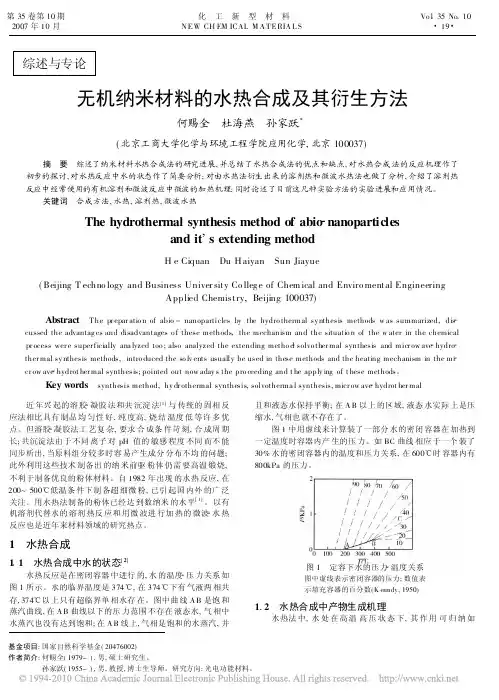
第35卷第10期2007年10月化 工 新 型 材 料N EW CH EM ICAL M A T ERIA L S Vo l 35No 1019综述与专论基金项目:国家自然科学基金(20476002)作者简介:何赐全(1979-),男,硕士研究生。
孙家跃(1955-),男,教授,博士生导师。
研究方向:光电功能材料。
无机纳米材料的水热合成及其衍生方法何赐全 杜海燕 孙家跃*(北京工商大学化学与环境工程学院应用化学,北京100037)摘 要 综述了纳米材料水热合成法的研究进展,并总结了水热合成法的优点和缺点,对水热合成法的反应机理作了初步的探讨,对水热反应中水的状态作了简要分析;对由水热法衍生出来的溶剂热和微波水热法也做了分析,介绍了溶剂热反应中经常使用的有机溶剂和微波反应中微波的加热机理;同时论述了目前这几种实验方法的实验进展和应用情况。
关键词 合成方法,水热,溶剂热,微波水热The hydrothermal synthesis method of abio nanoparticlesand it s extending methodH e Ciquan Du H aiyan Sun Jiayue(Beijing T echno logy and Business Univer sity Co lleg e of Chem ical and Enviro mental EngineeringApplied Chemistry,Beijing 100037)Abstract T he pr epar atio n of abio -nanoparticles by the hydro thermal sy nthesis methods w as summarized,discussed the advantag es and disadvantages o f these methods,the mechanism and the situatio n of the w ater in the chemical pr ocess wer e super ficially ana lyzed too ;also analyzed the extending metho d solvo ther mal synthesis and micr ow ave hydro ther mal sy nthesis methods,intro duced the so lv ents usually be used in these methods and the heating mechanism in the mi cr ow ave hydrot her mal synthesis;pointed out now aday s the pro ceeding and t he apply ing of t hese methods 。
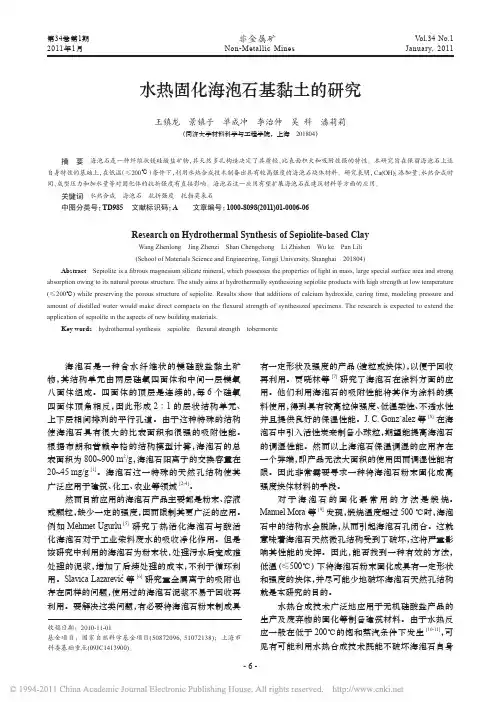
第34卷第1期非金属矿Vol.34 No.1 2011年1月 Non-Metallic Mines January, 2011海泡石是一种含水纤维状的镁硅酸盐黏土矿物,其结构单元由两层硅氧四面体和中间一层镁氧八面体组成。
四面体的顶层是连续的,每6个硅氧四面体顶角相反,因此形成2∶1的层状结构单元、上下层相间排列的平行孔道。
由于这种特殊的结构使海泡石具有很大的比表面积和很强的吸附性能。
根据布朗和普赖辛格的结构模型计算,海泡石的总表面积为800~900 m2/g,海泡石阳离子的交换容量在20~45 mg/g [1]。
海泡石这一特殊的天然孔结构使其广泛应用于建筑、化工、农业等领域[2-4]。
然而目前应用的海泡石产品主要都是粉末、溶液或颗粒,缺少一定的强度,因而限制其更广泛的应用。
例如Mehmet Ugurlu [5]研究了热活化海泡石与酸活化海泡石对于工业染料废水的吸收净化作用。
但是该研究中利用的海泡石为粉末状,处理污水后变成难处理的泥浆,增加了后续处理的成本,不利于循环利用。
Sla v ica Lazare v ić等[6]研究重金属离子的吸附也存在同样的问题,使用过的海泡石泥浆不易于回收再利用。
要解决这类问题,有必要将海泡石粉末制成具有一定形状及强度的产品(造粒或块体),以便于回收再利用。
贾晓林等[7]研究了海泡石在涂料方面的应用。
他们利用海泡石的吸附性能将其作为涂料的填料使用,得到具有较高拉伸强度、低温柔性、不透水性并且提供良好的保温性能。
J. C. Gonz´alez等[8]在海泡石中引入活性炭来制备小球粒,期望能提高海泡石的调湿性能。
然而以上海泡石保温调湿的应用存在一个弊端,即产品无法大面积的使用因而调湿性能有限。
因此非常需要寻求一种将海泡石粉末固化成高强度块体材料的手段。
对于海泡石的固化最常用的方法是煅烧。
Manuel Mora等[9]发现,煅烧温度超过500 ℃时,海泡石中的结构水会脱除,从而引起海泡石孔闭合。
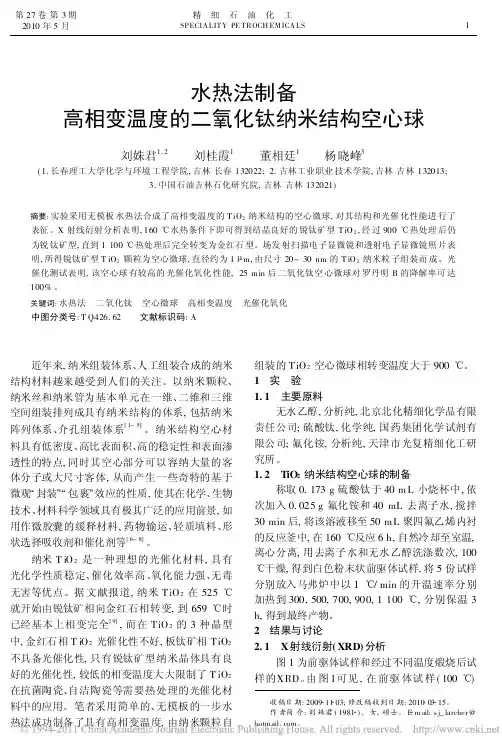
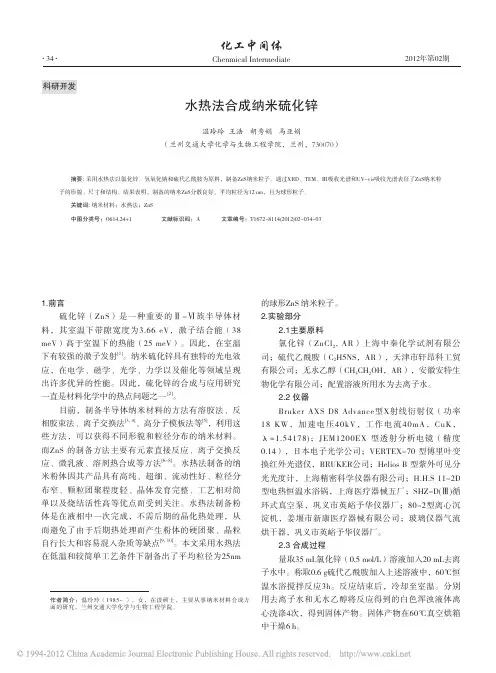
化工中间体Chenmical Intermediate · ·34 2012年第02期温玲玲 王浩 胡秀娟 马亚娟(兰州交通大学化学与生物工程学院,兰州,730070)1.前言硫化锌(ZnS)是一种重要的Ⅱ-Ⅵ族半导体材料,其室温下带隙宽度为3.66 eV,激子结合能(38 meV)高于室温下的热能(25 meV)。
因此,在室温下有较强的激子发射[1]。
纳米硫化锌具有独特的光电效应,在电学、磁学、光学、力学以及催化等领域呈现出许多优异的性能。
因此,硫化锌的合成与应用研究一直是材料化学中的热点问题之一 [2]。
目前,制备半导体纳米材料的方法有溶胶法、反相胶束法、离子交换法[3, 4]、高分子模板法等[5],利用这些方法,可以获得不同形貌和粒径分布的纳米材料。
而ZnS 的制备方法主要有元素直接反应、离子交换反应、微乳液、溶剂热合成等方法[6~8]。
水热法制备的纳米粉体因其产品具有高纯、超细、流动性好、粒径分布窄、颗粒团聚程度轻、晶体发育完整、工艺相对简单以及烧结活性高等优点而受到关注。
水热法制备粉体是在液相中一次完成,不需后期的晶化热处理,从而避免了由于后期热处理而产生粉体的硬团聚、晶粒自行长大和容易混入杂质等缺点[9, 10]。
本文采用水热法在低温和较简单工艺条件下制备出了平均粒径为25nm水热法合成纳米硫化锌的球形ZnS 纳米粒子。
2.实验部分2.1主要原料氯化锌(ZnCl 2, AR)上海中秦化学试剂有限公司;硫代乙酰胺(C 2H5NS,AR),天津市轩昂科工贸有限公司;无水乙醇(CH 3CH 2OH,AR),安徽安特生物化学有限公司;配置溶液所用水为去离子水。
2.2 仪器Bruker AXS D8 Advance型X射线衍射仪(功率 18 KW,加速电压40kV,工作电流40mA,CuK,λ=1.54178);JEM1200EX 型透射分析电镜(精度0.14),日本电子光学公司;VERTEX-70 型傅里叶变换红外光谱仪,BRUKER公司;Helios B 型紫外可见分光光度计,上海精密科学仪器有限公司;H.H.S 11-2D 型电热恒温水浴锅,上海医疗器械五厂;SHZ-D(Ⅲ)循环式真空泵,巩义市英峪予华仪器厂;80-2型离心沉淀机,姜堰市新康医疗器械有限公司;玻璃仪器气流烘干器,巩义市英峪予华仪器厂。
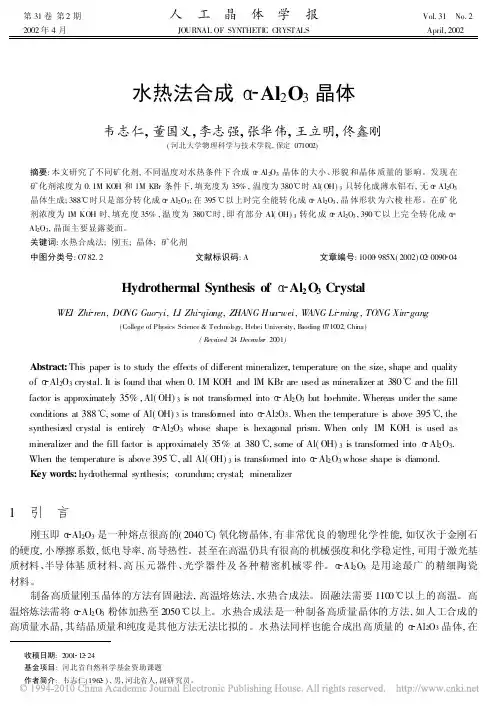
第31卷第2期人 工 晶 体 学 报Vol.31 No.2 2002年4月JOURNAL OF SYNTHETIC C RYSTALS April,2002水热法合成 Al2O3晶体韦志仁,董国义,李志强,张华伟,王立明,佟鑫刚(河北大学物理科学与技术学院,保定071002)摘要:本文研究了不同矿化剂,不同温度对水热条件下合成 Al2O3晶体的大小、形貌和晶体质量的影响。
发现在矿化剂浓度为0.1M KOH和1M KBr条件下,填充度为35%,温度为380 时Al(OH)3只转化成薄水铝石,无 Al2O3晶体生成;388 时只是部分转化成 Al2O3;在395 以上时完全能转化成 Al2O3,晶体形状为六棱柱形。
在矿化剂浓度为1M KOH时,填充度35%,温度为380 时,即有部分Al(OH)3转化成 Al2O3,390 以上完全转化成 Al2O3,晶面主要显露菱面。
关键词:水热合成法;刚玉;晶体;矿化剂中图分类号:O782.2 文献标识码:A 文章编号:1000 985X(2002)02 0090 04Hydrothermal Synthesis of Al2O3CrystalWE I Zhi ren,DO NG Guo yi,LI Zhi qiang,Z HANG Hua wei,WANG Li ming,TONG Xin gang(College of Physics Science&Technol ogy,Hebei Univers ity,Baoding071002,Chi na)(Rece ived24Dece mbe r2001)Abstract:This paper is to study the effects of different mineralizer,temperature on the size,shape and quality of Al2O3crystal.It is found that when0.1M KOH and1M KBr are used as mineralizer at380 and the fill factor is approximately35%,Al(OH)3is not transformed into Al2O3but boehmite.Whereas under the same conditions at388 ,some of Al(OH)3is transfor med into Al2O3.W hen the temperature is above395 ,the synthesized crystal is entirely Al2O3whose shape is hexagonal prism.When only1M KOH is used as mineralizer and the fill factor is approximately35%at380 ,some of Al(OH)3is transformed into Al2O3.When the temperature is above395 ,all Al(OH)3is transformed into Al2O3whose shape is diamond.Key words:hydrothermal synthesis;c orundum;crystal;mineralizer1 引 言刚玉即 Al2O3是一种熔点很高的(2040 )氧化物晶体,有非常优良的物理化学性能,如仅次于金刚石的硬度,小摩擦系数,低电导率,高导热性。
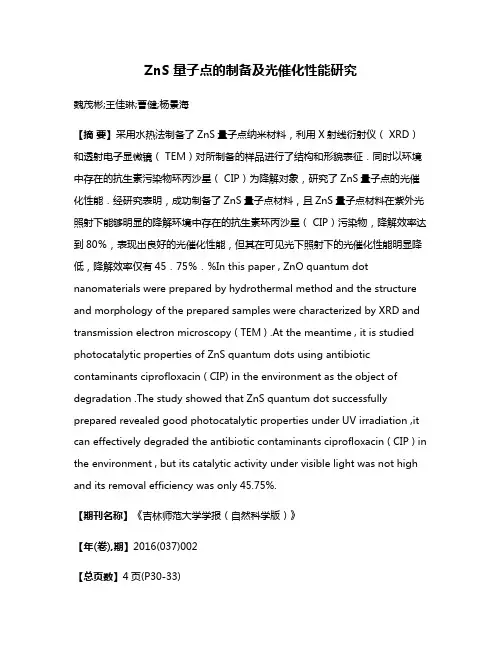
ZnS 量子点的制备及光催化性能研究魏茂彬;王佳琳;曹健;杨景海【摘要】采用水热法制备了ZnS量子点纳米材料,利用X射线衍射仪( XRD)和透射电子显微镜( TEM)对所制备的样品进行了结构和形貌表征.同时以环境中存在的抗生素污染物环丙沙星( CIP)为降解对象,研究了ZnS量子点的光催化性能.经研究表明,成功制备了ZnS量子点材料,且ZnS量子点材料在紫外光照射下能够明显的降解环境中存在的抗生素环丙沙星( CIP)污染物,降解效率达到80%,表现出良好的光催化性能,但其在可见光下照射下的光催化性能明显降低,降解效率仅有45.75%.%In this paper , ZnO quantum dot nanomaterials were prepared by hydrothermal method and the structure and morphology of the prepared samples were characterized by XRD and transmission electron microscopy ( TEM ) .At the meantime , it is studied photocatalytic properties of ZnS quantum dots using antibiotic contaminants ciprofloxacin ( CIP) in the environment as the object of degradation .The study showed that ZnS quantum dot successfully prepared revealed good photocatalytic properties under UV irradiation ,it can effectively degraded the antibiotic contaminants ciprofloxacin ( CIP ) in the environment , but its catalytic activity under visible light was not high and its removal efficiency was only 45.75%.【期刊名称】《吉林师范大学学报(自然科学版)》【年(卷),期】2016(037)002【总页数】4页(P30-33)【关键词】ZnS量子点;水热法;光催化性能;抗生素【作者】魏茂彬;王佳琳;曹健;杨景海【作者单位】吉林师范大学物理学院,吉林四平136000;吉林师范大学物理学院,吉林四平136000;吉林师范大学物理学院,吉林四平136000;吉林师范大学物理学院,吉林四平136000【正文语种】中文【中图分类】O643.3随着经济的快速发展,人类资源污染日趋加剧,对污染物的降解处理现已经是迫在眉睫了,是人类现今亟待解决的问题之一[1-2].抗生素污染物是一类难降解和含生物毒性物质多的有机污染物,环境的恶化严重威胁着人们的健康[3-4].纳米ZnS是一种优异的光催化半导体材料[5-7],因为纳米ZnS在一定条件下受激发能够产生大量的光子-空穴对,同时当ZnS粒子的粒径相当于其激子的玻尔半径时,材料将呈现出明显的量子尺寸效应,这一效应能够使其能级改变、能隙变宽,从而大大增强其氧化还原能力.因此,ZnS的制备及性能研究引起了广大科研工作者们的关注[8-13].本文采用水热法成功制备了ZnS量子点纳米材料,并以环境中存在的抗生素污染物环丙沙星(CIP)为降解对象,深入研究了ZnS量子点的光催化性能.利用水热法制备纤锌矿结构的ZnS纳米颗粒,按物质量比1∶2准确称量适量的醋酸锌和硫脲.然后,按照1∶1比例将水和乙二胺充分混合制成混合溶液,再将醋酸锌溶于此混合溶液中.将溶有醋酸锌的混合溶液在常温下搅拌1 h,使其充分溶合.再将硫脲加入到上述混合溶液中,将其用磁力搅拌器搅拌2 h.搅拌后,将所得的溶液放入反应釜中190 ℃条件下进行烧结12 h.取出反应釜中的产物,反复2次用去离子水对其进行超声清洗和离心干燥;最后,将清洗后的样品放置在真空干燥箱中在70 ℃下干燥至恒重,即得到粉末物质.晶体结构通过D/max-2500型X射线粉末衍射仪(XRD)和日本电子JEM-2100HR 型高分辨透射电子显微镜进行表征.材料性能利用Thermo Nicolet 360型红外光谱仪和日本岛津UV2450型紫外-可见漫反射谱(UV-Vis DRS)进行表征.图1(A)为水热法合成的ZnS样品的XRD谱图,从图中可知,在2θ角为28°,48°,56°处出现3个较强的衍射峰,这与ZnS的JCP-DS标准卡片(JCPDS No.36-1450)的(111),(220),(311)特征衍射峰的峰位置一一对应,并无其他杂峰出现,表明所制备的样品为纯度较高的纤锌矿结构ZnS纳米材料.由图1(B)样品的TEM图可知,样品的颗粒平均大小为5~6 nm,样品结晶良好,样品的晶格面间距为0.31 nm,说明所制备的样品为纤锌矿结构的ZnS量子点.图2为利用水热法制备纤锌矿结构ZnS量子点的UV-Vis光谱图.由图可知,ZnS 样品在300 nm区域有一个较强的紫外吸收,通过计算可知ZnS量子点的带隙宽度为3.82 eV[14].从图中可以看出,紫外吸收光谱具有明显的蓝移现象,这是因为本实验所制备的ZnS材料的颗粒大小接近于ZnS的玻尔半径(2.4 nm)[15]产生了量子尺寸效应所致.图3为水热法制备纤锌矿结构ZnS纳米颗粒的红外光谱图.由图中可知,3 500 cm-1和1 260 cm-1处出现了较强的振动峰,此吸收峰为ZnS样品中吸附水的—OH基团O—H键的振动峰,这说明ZnS量子点表面的Zn2+与—OH发生了较强的键合作用.1 610 cm-1处的吸收峰为醋酸锌中非对称和伸缩振动的特征吸收峰;1 400 cm-1处的吸收峰对应于醋酸锌中对称C—O伸缩振动的特征吸收峰;617 cm-1处的吸收峰应为ZnS的特征吸收峰.为了研究ZnS量子点材料光催化降解抗生素类污染物的性能,本实验接下来以环丙沙星(CIP)为降解对象,分别在只有紫外光作用、无ZnS光催化剂的情况下(如图4中曲线a)、无紫外光作用只有ZnS光催化剂的情况下(如图4中曲线b)和ZnS光催化剂在紫外光作用下(如图4中曲线c)对ZnS量子点材料的光催化性能进行了研究(如图4).由图中数据可知,数据a表明紫外光照射对CIP溶液没有降解作用,在照射40 min后吸光度值有所增加,这因为CIP自身发生了聚合作用所导致,因此CIP在紫外光照射下比较稳定,不容易被降解.从数据b可以看出CIP没有明显得到降解,并且变化较缓慢,降解率只有22.4%,这是由ZnS光催化剂自身对CIP溶液物理的吸附作用引起的.从数据c可以看出ZnS光催对CIP溶液具有明显的降解作用,40 min时其降解率就达到了62.7%,当照射时间为60 min时其降解率可达到80.3%.所以,本实验所制备的ZnS量子点材料在紫外光激发下对CIP具有良好的光催化降解能力.本实验也考察了可见光下ZnS量子点材料光催化降解染物环丙沙星(CIP)的性能.由图5可知,光照60 min后,ZnS光催化剂在可见光照射下对CIP的降解率为45.75%,可见此种条件下ZnS的催化活性较紫外光条件下大大降低了,如果再去除ZnS自身的物理吸附作用和可见光中少量的紫外光激发ZnS产生的光催化活性对CIP的降解,直接证明可见光下ZnS的催化活性较低.从图6中可以看出,插图a为未被紫外光光照过的CIP原溶液,从谱图中可看出只有在3.0 min处出现了一个单峰并且峰值很大,峰面积为550.2.将其溶液进行不同时间的光照,然后进行色谱分析,结果表明,随着光照时间的增加,3.0 min 处吸收峰的峰值明显减弱,峰面积大大减小,到紫外光光照60 min后,峰面积降低到36.4.在1.5 min和6.5 min处出现了新的峰,其峰值随着光照时间的增加出现不规则变化.因此,由CIP色谱峰的峰面积的变化可知,光照60 min后,ZnS光催化剂对CIP的降解率可以达到85%以上.这表明紫外光照射作用下光催化剂ZnS可以光催化降解CIP,达到去除环境中CIP污染物的目的.利用水热法成功制备了ZnS量子点纳米材料,并以环境中存在的抗生素污染物环丙沙星(CIP)为降解对象,研究了ZnS量子点的光催化性能.经研究表明,ZnS量子点材料在紫外光照射下具有良好的光催化性能,紫外光照射60 min时其降解率可达到80%,能够有效的降解环境中存在的抗生素环丙沙星(CIP)污染物.【相关文献】[1]ANGELAKIS A N,MAREKOS M H F,Bontoux L,et al.The status of wastewater reuse practice in the mediterrean basin-need for guidelines[J].Water Res,1999,33(10):2201-2217.[2]GALINDO C,JACQUES P,KALT A.Photooxidation of the phenylazonaphthol AO20 onTiO2:kinetic and mechanistic investigations[J].Chemosphere,2001,45(6-7):997-1005.[3]LINDBERG R H,WENNBERG P,JOHANSSON M I,et al.Screening of human antibiotic substances and determination of weekly mass flows in five sewage treatment plants in Sweden[J].Environ Sci Technol,2005,39(10):3421-3429.[4]陈杖榴,杨桂香,孙永学.兽药残留的毒性与生态毒理研究进展[J].华南农业大学学报,2001,22(1):88-91.[5]YIN H B,YUJI W D,TAKAYUKI K,SHOZO Y.Photoreductive dehalogenation of halogenated benzene derivatives using ZnS or CdS nanocrystallites asphotocatalysts[J].Environ Sci Technol,2001,35(1):227-231.[6]CHEN L F,SHANG Y Z,XU J,et al.Synthesis of ZnS nanospheres in microemulsion containing cationic gemini surfactant[J].J Disper Sci Technol,2005,27(6):839-842.[7]程丽娅,陈云,吴庆生.单分散ZnS纳米球与纳米梭之间的形貌转换及光学性能研究[J].化学学报,2007,65 (17):1851-1854.[8]LIU J Y,GUO Z,JIA Y,et al.Triethylenetetramine (TETA)-assisted synthesis,dynamic growth mechanism,and photoluminescence properties of radial single-crystalline ZnS nanowire bundles[J].J Cryst Growth,2009,311(5):1423-1429.[9]葛明,吴伟,徐斌,等.ZnS纳米球的水热合成剂光催化性能[J].南开大学学报,2008,41(6):33-38.[10]NIASARI M S,ESTARKI M R L,DAVAR F.Controllable synthesis of wurtzite ZnS nanorods through simple hydrothermal method in the presence of thioglycolic acid[J].J Alloys Compd,2009,475(1-2):782-788.[11]WANG H,CHEN Z,CHENG Q.Solvothermal synthesis and optical properties of single-crystal ZnS nanorods[J].J Alloys Compd,2009,478(1-2):872-875.[12]MOORE D F,ZHONG Y D,WANG L.Crystal orientation-ordered ZnS nanowirebundles[J].J Am Chem Soc,2004,126(44):14372-14373.[13]BISWAS S,GHOSHAL T,KAR S.et al.Cerium chloride methanol adductcrystals,CeCl3(CH3OH)4:preparation,crystallography,and scintillation properties[J].Cryst Growth Des,2008,8(7):2070-2072.[14]WANG L P,HONG G Y.A new preparation of zinc sulfide nanoparticles by solid-state method at low temperature[J].Mater Res Bull,2000,35(5):695-701.[15]YAO W T,YU S H,PAN L.Flexible wurtzite-type ZnS nanobelts with quantum-size effects:a diethylenetriamine-assisted solvothermal approach source[J].Small,2005,1(3):320-325.。
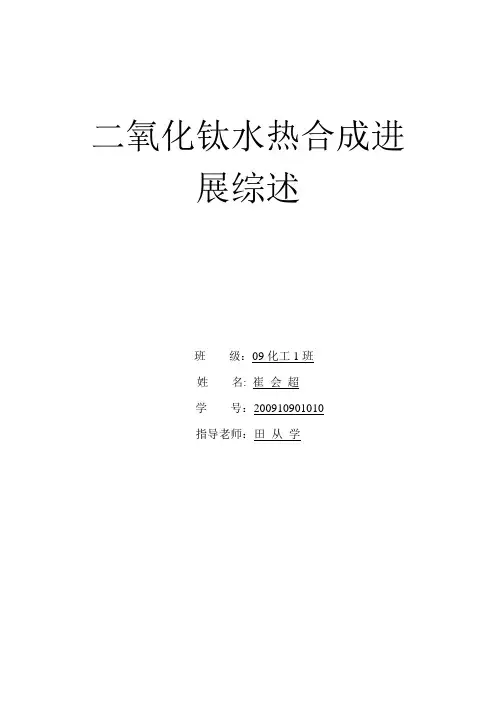
二氧化钛水热合成进展综述班级:09化工1班姓名: 崔会超学号:200910901010指导老师:田从学水热合成二氧化钛进展综述学生:崔会超 200910901010 指导老师:田从学(09化工一班攀枝花学院四川省攀枝花市 617000)943100346@摘要:二氧化钛是十分重要的纳米材料,目前制备二氧化钛的方法主要有气相法和液相法,其中水热合成属于液相法,又是合成二氧化钛的重要方法之一。
因此对其研究具有十分重要的意义。
水热合成法研究目前已经取得了一定的进展。
本综述从掺杂水热合成,低温水热合成,微波水热合成及水热合成二氧化钛的不同形态结构进行陈述。
关键词:二氧化钛水热合成纳米Hydrothermal synthesis of titanium dioxidesStudent: Cui Huichao Teacher :Tian CongxueAbstract:Titanium dioxides is very important nanometer material ,The preparation of Titanium dioxides methods mainly include gas phase method and liquid phase method, which belongs to the liquid phase method, hydrothermal synthesis, it is one of the important methods for titanium dioxides.So the research has very important significance.hydrothermal synthesis research has made some progress .This article from the doping hydrothermal synthesis, hydrothermal synthesis, microwave hydrothermal synthesis and hydrothermal synthesis of Titanium Dioxides different forms of structure state.Keywords:Titanium dioxides Hydrothermal synthesis nanometer material引言:水热合成法【1】是在特制的密闭反应容器(高压釜)里,采用水溶液作为反应介质,通过高温高压将反应体系加热至临界温度,使前驱物在水热介质中溶解,进而成核、生长、最终形成具有一定粒度和结晶形态的晶粒,卸压后经洗涤,干燥即可得到纳米级TiO2粉体。
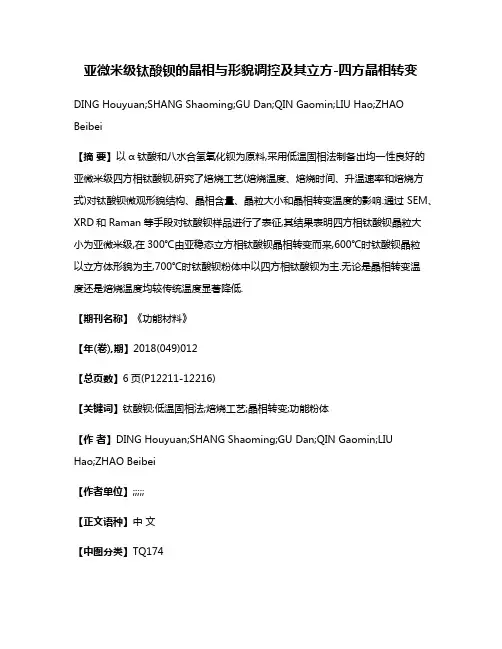
亚微米级钛酸钡的晶相与形貌调控及其立方-四方晶相转变DING Houyuan;SHANG Shaoming;GU Dan;QIN Gaomin;LIU Hao;ZHAO Beibei【摘要】以α钛酸和八水合氢氧化钡为原料,采用低温固相法制备出均一性良好的亚微米级四方相钛酸钡,研究了焙烧工艺(焙烧温度、焙烧时间、升温速率和焙烧方式)对钛酸钡微观形貌结构、晶相含量、晶粒大小和晶相转变温度的影响.通过SEM、XRD和Raman等手段对钛酸钡样品进行了表征,其结果表明四方相钛酸钡晶粒大小为亚微米级,在300℃由亚稳态立方相钛酸钡晶相转变而来,600℃时钛酸钡晶粒以立方体形貌为主,700℃时钛酸钡粉体中以四方相钛酸钡为主.无论是晶相转变温度还是焙烧温度均较传统温度显著降低.【期刊名称】《功能材料》【年(卷),期】2018(049)012【总页数】6页(P12211-12216)【关键词】钛酸钡;低温固相法;焙烧工艺;晶相转变;功能粉体【作者】DING Houyuan;SHANG Shaoming;GU Dan;QIN Gaomin;LIUHao;ZHAO Beibei【作者单位】;;;;;【正文语种】中文【中图分类】TQ1740 引言四方相钛酸钡(T-BaTiO3)由于其较好的压电、铁电性能、低介电损耗和高介电常数等优点,广泛应用在多层陶瓷电容器(MLCC)、光电器件、PTC热敏电阻和压电传感器等电子元器件中[1-4]。
随着电子元器件小型化和高性能化趋势发展,一种具有结晶度高、晶相含量高、纯度高、粒度分布窄、均一性好和粒径小而可调控等特征[5-7]的T-BaTiO3粉体,具有良好的应用前景与价值。
传统固相法[8-9]制备钛酸钡(BaTiO3)是通过高温下焙烧BaCO3和TiO2获得的,该法得到的BaTiO3晶粒大小多为微米级、均匀性较差、表面活性差和高度团聚等缺点。
由于传统固相法无法满足要求,更多的展开溶胶-凝胶法[10-11]、水热法[13-14]和沉淀法[15]等液相法进行BaTiO3的制备研究,然而液相法也存在着结晶度和四方相含量低等粉体质量问题,以及制备过程中的废液产生、成本和二次煅烧带来的能耗等问题。
水热法合成锐钛矿型纳米二氧化钛①杜作娟,古映莹(中南大学功能材料化学研究所,湖南长沙,410083)摘 要:以Ti(SO4)2为原料,采用水热法制备了锐钛矿型二氧化钛纳米粉体,利用XRD、激光粒度仪等分析测试手段对所得二氧化钛粉体的晶相组成、粒径分布等性质进行了表征。
探讨了反应温度和反应时间对粉体晶型及粒径的影响。
关键词:水热法;纳米粉体;二氧化钛;锐钛矿中图分类号:TQ134.1 文献标识码:A 文章编号:1009-9212(2002)05-0024-02 水热法是指在特别的密闭反应容器(高压釜)里,采用水溶液作为反应介质,通过对反应容器加热,创造一个高温、高压反应环境,使得通常难溶或不溶的物质溶解并且重结晶[1]。
由于水热反应是在非受限的条件下进行,因此在制备纳米粉体上与其它湿化学方法相比有许多优越性[2],如具有在高温高压下一次完成,无需后期晶化处理,所制得粉体粒度分布窄,团聚程度低,成分纯净,制备过程污染小,易实现工业化生产等优点。
近年来用水热法制备TiO2粉体的研究较多[3~6]。
笔者采用新工艺,以Ti(SO4)2溶液为原料,在较低的温度下(200℃以下)和较短的时间(8h以下),水热合成了锐钛矿相纳米TiO2。
1 实验部分1.1 纳米TiO2的制备在搅拌的条件下将Na2CO3溶液加入一定浓度的Ti(SO4)2水溶液中,调整pH<3.0,制得前驱体,放入衬有聚四氟乙烯的高压容器内加热,填充度为80%,控制反应温度和反应时间。
所得产物用丙酮和蒸馏水依次洗涤至滤液无SO2-4检出,在100℃下干燥即得产物。
1.2 样品表征采用XRD、激光粒度分析仪等对所得粉体进行结构、形貌表征。
2 结果与讨论2.1 纳米TiO2的晶型分析在160℃下反应6h所得二氧化钛粉体的XRD 的分析结果如图1所示。
图2和图3分别是反应时间6h时不同温度及反应温度为160℃时不同反应时间下的XRD图。
从图中可以看出,不同条件下所制得粉体的所有衍射峰都能为锐钛矿相二氧化钛所指标化,且衍射峰峰型尖锐,表明所得粉体为结晶完整的锐钛矿型二氧化钛。
专利名称:Apparatus for producing a single crystal,and single crystal manufacturing method发明人:岡戸 貞男,鈴木 崇雄,堀川 晃司申请号:JP2012509603申请日:20110331公开号:JPWO2011125891A1公开日:20130711专利内容由知识产权出版社提供专利附图:摘要: Cost is inexpensive, I want to be able to manufacture in the hydrothermalsynthesis method, single crystals of various devices for high-quality low-metal content of the impurity content. In the single crystal manufacturing apparatus installed for growing container of a single crystal in the autoclave, to produce a single crystal by thehydrothermal synthesis method by installing a seed crystal in this vessel, said for growingcontainer, pure titanium, pure tantalum and is characterized in that and it is one that is produced by at least one metal selected from the group consisting of pure zirconium.申请人:東京電波株式会社地址:東京都大田区大森西1丁目12番18号国籍:JP代理人:泉名 謙治,小川 利春更多信息请下载全文后查看。
溶剂热法制备CuSe纳米线薄膜丁筛霞;葛新亚;刘良富【摘要】Hexagonal copper selenide nanowires films on copper substrates have been synthesized via solvothermal reaction by using Cu foil and Se powder as raw materials and benzene as solvent, through changing the molar ratio and concentrations of reactants, temperature and time. The composition and morphology of the as-prepared products were respectively characterized by X-ray diffraction (XRD), field-emission scanning electron microscopy (FESEM), transmission electron microscopy (TEM), the possible formation of copper selenide nanowires film was discussed. The luminescence properties of the final products were characterized fluorospectrophotometry. The results indicate that the as-prepared copper selenide nanowires with the diameter of 100~200 nm and lengths up to 5 μm. The photo-luminescence peaks of copper selenide nanowires films is located at 301 nm.%以铜片和硒粉为原料,苯为溶剂,通过调控反应物的配比、反应物浓度、反应温度和反应时间等因素,采用溶剂热法直接在铜基底上制备出六方晶系的硒化铜纳米线薄膜.分别利用X-射线转靶衍射仪(XRD),场发射扫描电子显微镜(FESEM),透射电子显微镜(TEM)表征了产物的晶体结构与形貌,探索了CuSe纳米线薄膜的形成过程,并使用荧光分光光度法(PL)对最终产物的性质进行了表征.实验结果表明:这种CuSe纳米线的直径为100~200 nm,长度为5 μm,其荧光发光峰为301 nm.【期刊名称】《中北大学学报(自然科学版)》【年(卷),期】2012(033)002【总页数】4页(P164-167)【关键词】CuSe;纳米线;薄膜;溶剂热【作者】丁筛霞;葛新亚;刘良富【作者单位】安徽职业技术学院材料工程系,安徽合肥230011;安徽职业技术学院材料工程系,安徽合肥230011;安徽职业技术学院材料工程系,安徽合肥230011【正文语种】中文【中图分类】O613.52近年来,一维半导体纳米线的合成与性能研究逐渐被人们所重视,它们在纳米器件的制造、光学、电化学和机电设备方面有潜在的应用价值[1].过渡金属硒化合物一维半导体纳米材料,由于其特殊的物理、化学性质,目前正为人们所广泛研究[2-3].Cu2-xSe是一种p型半导体,因其具有良好的光电、电光转化等性质,在太阳能电池、光学过滤器、热电、超导体和催化等方面有潜在的应用价值[4].最近,许多报道都是关于各种形貌硒化铜微米或纳米晶体粉末的制备[5-7],也有少数报道是关于 CuSe薄膜的制备.S.R.Gosavi等人[8]以 Se粉,Na2SO3,CuCl2◦ 2H2O和NH3◦ H2O为原料,在室温下合成了由球状微米颗粒组成的 CuSe薄膜.V.M.Garcia 等人[9]以CuSO4◦ 5H2O,NH3◦H2O和自制的 Na2SeSO3为原料,在室温下采用化学浴合成了六方硒铜矿结构的 CuSe薄膜.M.Dhanam 等人 [10]以CuSO4◦5H2O,C6H5Na3O7◦2H2O,Na2SO3和 Se粉为原料,在不同的 pH值条件下分别合成了立方结构的 Cu2-xSe薄膜和四方结构的 Cu3Se2薄膜.本文在70℃水浴的温和反应条件下,以 Cu片为 Cu源和基底结合苯热法制备出了CuSe纳米线薄膜,并探讨了 CuSe纳米线的形成机理,研究了产物的发光性质.1 实验1.1 样品制备实验所用原料为铜片、硒粉和苯.以上试剂均为分析纯国产化学试剂,实验用水为蒸馏水.称取 0.01 g的 Se粉,加入到 60 m L磨口瓶中;再量取 20 m L苯溶剂到 60 mL磨口瓶中,并摇晃均匀;然后将丙酮超声清洗过的铜片(15×0.5× 0.25 mm3)放入其中,将磨口瓶置于70℃恒温水浴锅中 8 h后取出,样品用蒸馏水和无水乙醇清洗数遍后,在空气中晾干.1.2 产物表征采用 D/max-γ B型 X射线衍射仪(X-ray diffraction,XRD)对样品进行物相分析.以Cu Kα为辐射源,λ=1.5418Å ,管电压为 40 kV,管电流为 100 mA,扫描范围在10°~70°.用加速电压为 20 kV的 FEI Sirion-200型场发射扫描电镜(Field Emission Scanning Electron Microscopy,FESEM)和加速电压 200 kV的Hitachi-800型透射电子显微镜(Transmission Electron Microscopy,TEM)表征样品的形貌和结构.用 Hitachi F-4500型荧光分光光度计(Fluorospectro-photometry,PL),激发光源为Xe灯,在室温下测试样品的荧光光谱.2 结果与讨论2.1 产物的 XRD分析图1为铜片于含 Se的苯溶液中在70℃反应8 h所得产物的X射线衍射花样.除了标有“◦”号的两个衍射峰来自铜基底外(JCPDF 04-0836),其它所有的衍射峰都均可指标化为六方相的 CuSe(JCPDS 34-0171).没有检测到明显的杂质峰,说明产物为纯相的 CuSe.所得产物的 X射线衍射峰较强,半峰宽较窄,表明所得产物具有较好的结晶性.图1 产物的 X射线衍射花样Fig.1 X-ray diffraction pattern of the product 2.2 CuSe薄膜的 SEM和 TEM分析图2为在70℃恒温水浴中反应 8 h所得产物的 FESEM照片和 T EM照片.由图2(a)可见,薄膜的表面是由大量的线组成的,图中显示CuSe纳米线的长度大约有5μ m.图 2(b)为纳米线的高倍 FESEM照片,可以清晰地看出纳米线的直径约为 100~200 nm.图 2(c)为 CuSe纳米线的 TEM照片,由图可见 CuSe纳米线直径约为100~ 200 nm,长度达5μ m左右,与 FESEM照片结果一致.图2 CuSe薄膜的 FESEM照片和 TEM照片Fig.2 FESEM and T EM pho tographs of CuSe film2.3 CuSe薄膜的形成机理分析为了研究 CuSe薄膜的形成机理,本文制备了不同反应时间段的产物,并分别研究了其 XRD和 FESEM结果.首先对在70℃水浴中恒温反应了 3 h,6 h和 8 h的产物的结构和组成进行了XRD分析(图 3).图 3中各产物的衍射峰除了标有“◦”号的两个衍射峰来自铜基底外(JCPDF 04-0836),所有衍射峰都均可指标化为为六方相的CuSe(JCPDS 34-0171).图 3的 3个薄膜样品的XRD图表明:在水浴中铜片与含Se的苯溶液恒温反应不同时间所得的产物都是六方相的 CuSe.图3 不同反应时间产物的 X射线衍射花样Fig.3 X RD patterns of the CuSe products prepared after different reaction time该反应属于典型的溶剂热反应.反应方程为对于本实验,M即为 Cu,Y为 Se.Li Yadong等[11-12]用 Cd粉末与 Se单质,在120~200℃温度条件下的有机溶剂中,制得了 CdSe纳米材料.根据 Li Yadong等[11-12]提出的溶剂配位分子模板机理,可以推断本文 CuSe纳米线薄膜制备的化学反应过程亦与之类似,主要为当将 Cu片加入到含 Se的苯溶剂中时,Cu与 Se发生了电子转移,形成了 Cu2+与Se2-.反应开始时温度较低,在 Cu片表面形成的 Cu2+随即与溶剂发生反应,生成了低温而且较稳定的络合物 [Cu(solvent)2]2+.随着反应温度的升高,络合物的稳定性降低并发生分解,因而溶剂中的Se2-与从络合物中分解出来的 Cu2+反应而生成了CuSe(3).图4是反应物在70℃水浴中恒温反应了3 h,4 h,6 h和 8 h的产物的 FESEM照片.图 4(a)是反应 3 h得到的 CuSe薄膜的 FESEM照片,可以看出产物的形貌是一些大小约为1μm的大颗粒.如图 4(b)所示,当反应时间达到 4 h时,产物的形貌为片状颗粒,并有少量线生成.当反应时间延长到 6 h时,产物的形貌是大量的薄片和少量的纳米线(图 4(c)).图 4(d)是反应 8 h的产物的 FESEM照片,从图中可以看出产物形貌为长为十几微米的纳米线.图4 不同反应时间产物的 FESEM照片Fig.4 FESEM photog raphs of the CuSe products prepared after different reaction time由上述生长过程中产物的形貌照片,可推测CuSe纳米线的生长机理为:该反应首先得到的产物是 CuSe颗粒,随着反应时间的延长,温度的升高,溶液中 Se2-的浓度越来越大,此时大量的Se2-参与反应,生成的大颗粒逐渐堆积进而自组装形成薄片.当反应时间进一步延长时,薄片不断生长并逐步裂解为线,最终形成了 CuSe纳米线薄膜.铜-氧族化合物由于自身的结构易于形成片状产物,并且在一定的环境下也易于裂解形成线状形貌的产物,这在作者以前对铜-氧族化合物的研究[13-14]中已经有所体现,其具体原理与之类似.2.4 CuSe纳米线薄膜的发光性质图5为 CuSe纳米线的荧光光谱图.测试条件为:Xe灯光源,激发波长λex=249 nm,激发侧和发射侧狭缝宽度均为 5 nm.如图 5所示,在301 nm处有较强的光致发光峰,与文献 [6]中非常接近.这说明本文所制备的 CuSe纳米线薄膜具有一定的光学性质,在光学器件方面可有潜在的应用.图5 室温下 CuSe纳米线薄膜的荧光(PL)光谱Fig.5 Fluorescence spectra of the CuSe nanowires film at room temperature3 结论以 Cu片和 Se粉为原料,采用苯热法制备出了六方晶系的硒化铜纳米线薄膜,纳米线的直径约为 100~ 200 nm,长度为5μ m左右.产物 CuSe纳米线薄膜在 301 nm处有一个光致发光峰,说明其具有荧光发光性质,这为 CuSe材料在光学方面的潜在应用作了有意义的初步探索.参考文献:[1]Tan Y W,Xue X Y,Peng Q,et al.Controllable fabrication and electricalperformance of single crystalline Cu2O nanowires with high aspect ratios[J].Nano.Lett.,2007,7:3723-3728.[2]Zhang S Y,Fang C X,Wei W,et al.Synthesis and electrochemical behavior of crystalline Ag2Se nanotubes[J].J.Phys.Chem.C,2007,111:4168-4174. [3]Shi L,Xu Y M,Li Q.Controlled fabrication of ZnSe arrays ofwell-aligned nanorods, nanowires, and nanobelts with a facile template-free route[J]. J.Phys.Chem.C,2009,113:1795-1799.[4]Xu J,Zhang W X,Yang Z H,et rge-scale synthesis oflong crystalline Cu2-xSe nanowire bundles by water-evaporation-induced self-assembly and their application in gas sensing[J].Adv.Funct.Mater.,2009,19:1-8.[5]张翠成,陈春年,蒋利民,等.牺牲模板法硒化铜纳米管的制备与表征 [J].合肥工业大学学报(自然科学版),2010,33(3):449-452.Zhang Cuicheng,Chen Chunnian,Jiang Limin,et al.Preparation and characterization of CuSe nanotubes by sacrificial templates[J].Journal of Hefei University of Technology(Natural Science),2010,33(3):449-452.(in Chinese)[6]王新军,李可,董玉涛 ,等.CuSe纳米片、纳米棒簇的水热合成研究[J].河南师范大学学报(自然科学版),2010,38(3):86-89.Wang Xinjun, Li Ke, Dong Yutao, et al.Hydrothermalsynthesis of CuSe nanoflakes and nanorods[J].Journal of Henan Normal University(Natural Science),2010,38(3):86-89.(in Chinese) [7]Wei W,Zhang S Y,Fang C X,et al.Electrochemical behavior and electro-generated chemiluminescence of crystallineCuSe nanotubes[J]. Solid State Sci.,2008,10:622-628.[8]Gosavi S R,Deshpande N G,Gudage Y G,et al.Physical,optical and electrical properties of copper selenide(CuSe)thin films deposited by solution growth technique at room temperature[J].J.AlloysCompd.,2008,448:344-348.[9]Garcm V M,Nair P K,Nair M T S.Copper selenide thin films by chemical bath deposition[J].J.Cryst.Growth,1999,203:113-124.[10]Dhanam M,Manoj P K,Prabhu R R. Hightemperature conductivity in chemical bath deposited copper selenide thinfilms[J].J.Cryst.Growth,2005,280:425-435.[11]Li Y D,Liao HW,Ding Y.Nonaqueous synthesis of CdS nanorod semiconductor[J]. Chem. Mater.,1998,10:2301-2303.[12]Li Y D,Liao HW,Ding Y.Solvothermal Elemental Direct Reaction toCdE(E= S, Se, Te)Semiconductor Nanorod[J].Inorg.Chem.,1999,38:1382-1387.[13]Zhang W X,Ding S X,Yang,Z H,et al.Growth of novel nanostructured copper oxide(CuO)films on copper foil[J].J.Cryst.Growth,2006,291:479-484.[14]Zhang W X,Xu J,Yang Z H,et al.Mesoscale organization ofCu7S4nanowires:Formation of novel sheath-like nanotubearray[J].Chem.Phys.Lett.,2007,434:256-259.。
化学浴法制备花状多级结构CdO及其气敏性能研究尹红哲;程晓丽;徐旸;徐英明;霍丽华;高山【摘要】A novel flower-like hierarchical CdO nanostructures were synthesized using a chemical bath deposition method followed by subsequent calcination at 500℃. X-ray diffraction (XRD), Fourier Transform Infrared Spec-troscopy(FT-IR) and scanning electron microscopy (SEM) were employed to characterize and analyze the CdO nanostructures before and after calcination. The coral-like structured CdO are composed by nanoparticles and were coated onto a ceramic tube to form a thick film sensor. This thick film sensor exhibited good sensitivities to ethanol, acetone and liquefied petroleum gas. The response of sensor to 1 000 μL o L-1 ethanol is 1.73 with a response time of 10 s and a recovery time of 15 s.%采用化学浴法制备了前躯体,经过500℃热处理后获得花状多级结构的CdO,利用X射线衍射(XRD)、傅里叶变换红外光谱(FT-IR)、扫描电子显微镜(SEM)对产物的结构和形貌进行了表征,得到的花状多级结构CdO由200~400 nm厚的片层叠加而成,而片层则进一步由纳米粒子构筑的珊瑚礁所形成.对该CdO花厚膜型元件的气敏性能研究表明,该材料在410℃对丙酮更敏感,在485℃则对乙醇、丙酮及液化石油气(LpG)均表现出较好的气敏性,其中对1 000 μL·L-1乙醇的灵敏度为1.73,响应时间为10 s,恢复时间为15 s.【期刊名称】《黑龙江大学自然科学学报》【年(卷),期】2013(030)001【总页数】5页(P95-99)【关键词】CdO;多级结构;化学浴法;气敏性能【作者】尹红哲;程晓丽;徐旸;徐英明;霍丽华;高山【作者单位】黑龙江大学化学化工与材料学院功能无机材料化学教育部重点实验室,哈尔滨150080【正文语种】中文【中图分类】O614.2CdO是一种重要的窄带隙(2.2~2.7eV)半导体氧化物,具有较高的电导率(约103S·cm-1)和透光度(约90%),在太阳能电池、电池阴极材料、气敏传感器、透明电极、光学晶体管等领域有着广泛的应用前景[1-3]。
OriginalarticleHydrothermal synthesis of single-crystal CeCO3OH and their thermal conversion to CeO2Kun Gao a,Yi-Yang Zhu a,Da-Qing Tong a,Li Tian a,Zhao-Hui Wang a,b,Xiao-Zu Wang a,*a College of Chemistry and Chemical Engineering,Nanjing University of Technology,Nanjing210009,Chinab State Key Laboratory of Materials-Oriented Chemical Engineering,Nanjing University of Technology,Nanjing210009,China1.IntroductionIn recent years,cerium compounds have been widely used incatalysis[1–4],fuel cells[5]and chemical materials[6–8]due totheir specific4f energy levels of the Ce-element[9,10].Among allthe cerium compounds,cerium carbonate hydroxide,as animportant functional material,has been attracted much attentionbecause of its novel electronic properties,optical properties andchemical characteristics arising from their4f electrons[9–12].Recently,cerium carbonate hydroxide with different morphol-ogies was synthesized by different methods,such as self-assembly,sonochemical[13,14],hydrothermal[15–18],and microwave-assisted hydrothermal route[19].Among all the preparationmethods,the hydrothermal process is considered to be an effectiveand economical route due to its merits of low synthesistemperature,high powder reactivity and versatile shape control[20–23].In a hydrothermal system,CeCO3OH with differentstructures corresponding to distinct morphologies have beensynthesized[18,24,25].There have been sufficient studies report-ing on the synthesis of different morphologies,for example,Guoet al.reported the synthesis of triangular micro-plate,bundle-like,shuttle-like andflower-like structures of CeCO3OH by hydrother-mal method[15,16,18].Li and Zhao synthesized single-crystallineCeCO3OH with dendrite-like structures through a facile hydro-thermal method and obtained CeO2by heating CeCO3OH at5008Cfor6h[26].Zhang et al.synthesized CeCO3OH rhombic micro-plates by the precipitation method in the presence of3-aminopropyltriethoxysilane[28].However,most of these reportson the synthesis of CeCO3OH micro/nanoparticles were preparedusing CO(NH2)2or HMT as the alkaline and carbon resource[13–18]and added surfactant or template to adjust the nucleation andcrystal growth of CeCO3OH particles[13,15–18,28],which makesthe process complex and raw materials more costly.So it isimportant to explore a facile method to synthesize morphology-controlled CeCO3OH micro/nanomaterials.In this paper,we report a simple method to synthesize dendrite-like CeCO3OH crystallites using CeCl3Á7H2O as the cerium source,triethylenetetramine as both an alkaline and carbon source.Thepolycrystalline CeO2was obtained by calcination of the precursor at5008C for4h,partly maintaining the dendrite-like morphology.Theoptical absorption properties of CeO2were also investigated.2.ExperimentalAll chemical reagents were of analytical grade without furtherpurification.In a typical synthesis,0.001mol of CeCl3Á7H2O wasdissolved in60mL deionized water to form a clear solution,andthen0.30mL triethylenetetramine was added to the transparentsolution in order to completely react with Ce3+at258C for about0.5h with continued stirring.The resulting homogenous solutionChinese Chemical Letters25(2014)383–386A R T I C L E I N F OArticle history:Received10August2013Received in revised form8September2013Accepted26September2013Available online1December2013Keywords:CeCO3OHHydrothermalCerium carbonate hydroxideNanostructuresA B S T R A C THexagonal single-crystalline cerium carbonate hydroxide(CeCO3OH)precursors with dendritemorphologies have been synthesized by a facile hydrothermal method at1808C using CeCl3Á7H2O asthe cerium source,triethylenetetramine as both an alkaline and carbon source,with triethylenete-tramine also playing an important role in the formation of the dendrite structure.Polycrystalline ceria(CeO2)have been obtained by calcining the precursor at5008C for4h.The morphology of the precursorwas partly maintained during the heating process.The optical absorption spectra indicate the CeO2nano/microstructures have a direct band gap of2.92eV,which is lower than values of the bulk powderdue to the quantum size effect.The high absorption in the UV region for CeO2nano/microstructureindicated that this material was expected to be used as UV-blocking materials.ß2013Xiao-Zu Wang.Published by Elsevier B.V.on behalf of Chinese Chemical Society.All rightsreserved.*Corresponding author.E-mail address:wangxiaozu@(X.-Z.Wang).Contents lists available at ScienceDirectChinese Chemical Lettersj o u rn a l h om e p a g e:w w w.e l s e v i e r.c o m/l o c a t e/c c l e t1001-8417/$–see front matterß2013Xiao-Zu Wang.Published by Elsevier B.V.on behalf of Chinese Chemical Society.All rights reserved./10.1016/let.2013.11.047was transferred to a 100mL Teflon-line stainless steel autoclave,which was sealed and maintained at 1808C for 24h,and cooled to room temperature naturally.The white precipitate was collected by centrifugation,washed several times with distilled water and ethanol,and dried at 708C for 6h.The as-synthesized CeCO 3OH was calcined to produce straw-yellow CeO 2in air at 5008C for 4h.The XRD measurements were performed on a Bruker-D8Advanced X-ray diffractometer,equipped with graphite-monochromatizedhigh-intensity Cu K a radiation (l =1.5418A˚).The morphologies and sizes of the resulting products were examined by field-emission scanning electron microscopy (FESEM,Hitachi S-4800)and transmission electron microscopy (TEM,JEM2000EX),respec-tively.The thermal behavior of the resulting products was carried out by differential scanning calorimetric analysis (DSC)and thermogravimetric analysis (TG)with a Netzsch-449C simulta-neous TG/DSC apparatus heating from room temperature to 6008C (108C/min)in flowing air.UV/vis absorption spectra were acquired on a spectrophotometer (Shimadzu)and the analyzed range was 200–800nm.3.Results and discussionFig.1presents the typical XRD pattern of the as-synthesized CeCO 3OH products.All of the diffraction peaks in Fig.1can be exactly indexed to the pure hexagonal crystalline phase ofCeCO 3OH with lattice constants a =7.2382A˚,c =9.9596A ˚,which are in good agreements with the literature values (JCPDS 32-0189).No impurity peaks are detected,indicating the high purity of the final product.The strong and sharp diffraction peaks suggest that the products are highly crystallined.Fig.2shows a typical SEM image of the CeCO 3OH dendrite structure synthesized at 1808C for 24h.As shown in Fig.2,it reveals most of the as-prepared CeCO 3OH products display twofold-symmetric structures with a length of 1–2m m along the trunk.The detailed morphology of the structures of CeCO 3OH dendrites is further studied using TEM and SAED (Select-area electron diffraction).A typical high magnification TEM image of the structure of CeCO 3OH dendrites is shown in Fig.3.It reveals that the product is composed of a long central trunk with secondary and tertiary sharp branches,which are parallel to each other and emerge at 608angles with respect to the central trunk.The SAED pattern in the inset of Fig.3taken from an individual dendrite-like nanostructure is indexed to hexagonal CeCO 3OH,indicating that the individual is a single crystal.The diffraction pattern indicates the individual dendrite-like CeCO 3OH is well crystallized.The typical TG pattern of the as-prepared CeCO 3OH dendrite structure is shown in Fig.4a.The TG curve shows that CeCO 3OH begins to decompose at about 2808C and finishes at 6008C.Thetotal weight loss between 2808C and 6008C is measured at about 21.70%,which is close to the results in the theoretical value calculated from following reaction:4CeCO 3OH þO 2!4CeO 2þ2H 2O þ4CO 2(1)The DSC curve (Fig.4b)shows one endothermic peak with a maximum at 300.08C.The temperature range of the endothermic peak in the DSC curve agrees well with the weight loss in the TG curve,corresponding to endothermic behavior during the thermal decomposition/oxidation of CeCO 3OH to CeO 2.Fig.5shows the XRD pattern of CeO 2obtained by calcinations of as-prepared CeCO 3OH.All of the peaks are well assigned to pure face-centered cubic (fcc)structure of CeO 2with lattice constantsa =5.412A˚,which is in good agreement with the JCPDS card (No.43-1002).No obvious peaks for other elements or impurities were observed.The strong and sharp reflection peaks suggest that the as-prepared products are well crystallized.After the CeCO 3OH dendrites are calcined in air at 5008C for 4h,CeO 2dendrites are formed.As shown in Fig.6a,SEM image of CeO 2reveals that the dendrite morphology was partly sustained after thermal decomposition/oxidation to CeO 2.Fig.6b presents a typical TEM image of CeO 2dendrite and its corresponding ED pattern (Fig.6b inset).The discontinuous rings in ED pattern indicate that it could consist of CeO 2polycrystals with an oriented crystallographic axis.In our experiment,since triethylenetetramine was not used,noting products were obtained.Fig.7shows the SEM image of raw material (CeCl 3Á7H 2O),only erose particles were observed,indicating the triethylenetetramine plays an important role in the formation of CeCO 3OH dendrite structures.As is well known,triethylenetetramine at the room tempera-ture will release OH Àin the aqueous solution.Meanwhile,triethylenetetramine has large average capacities for the absorp-tion CO 2[27].So the CO 32Àanions in the solution may result from1020304050602θ (° )(002)(110)(112)(004)(300)(114)(302)(220)(222)(304)Fig.1.XRD patternof the CeCO 3OH dendrite-like nanostructure.Fig.2.SEM image of the as-synthesized CeCO 3OH.Fig.3.TEM image of the as-synthesized CeCO 3OH.K.Gao et al./Chinese Chemical Letters 25(2014)383–386384the possible oxidation of triethylenetetramine,the absorption andslight dissolution of CO 2from air.In the hydrothermal process,the C—N bond in triethylenete-tramine is the easiest bond to break,so upon heating to a certain temperature,triethylenetetramine hydrolyzes to form NH 4+and CO 32À.The cerium ions can exist in the form of [Ce(H 2O)n ]3+in aqueous solution,and then [Ce(H 2O)n ]3+is changed into [Ce(OH)(H 2O)n +]2+,and finally CeCO 3OH is obtained by the reaction between [Ce(OH)(H 2O)n À1]2+and CO 32À.It is proposed that dendrite structures are obtained through a seed-mediated growth in the presence of micelles of triethylenetetramine.The CeCO 3OH nuclei were created and used as seed center,these random moving nuclei in the environment can aggregate with each other to form anisotropic morphology.In our experiment,we consider that triethylenetetramine used as the alkaline and surfactant in the hydrothermal process.Therefore,existing triethylenetetramine,as a capping agent in the reaction system,is absorbed selectively on the different planes of CeCO 3OH seeds,helps to lower the surface energy and results in the different growth rate of different planes to form the dendrite structures.The real formation mechanism of CeCO 3OH dendrite structure needs further investigation.Fig.8shows the UV/vis diffuse absorption spectra of CeCO 3OH and CeO 2.Fig.8a shows the UV/vis absorption spectra for CeCO 3OH.The spectra displayed a strong absorption band below 400nm in the spectra.As seen in Fig.8b and 8c,when the synthesized particles were calcined to produce straw yellow CeO 2by heating at 5008C for 4h,the CeO 2has a stronger absorption band below 480nm in the spectra,which is originated from change-transfer transition between O 2p and Ce 4f bonds [28–30].The optional band gap E g can be determined based on the absorbance spectrum of the powders by the following equation:E g =1240/l AE ,where l AE is the edge wavelength of absorbance.The onset of absorption for CeO 2is at 425.3nm,which corresponds to the band gap energy (E g )of 2.92eV,lower than the values of bulk100200300400500600700800024681012←b. DSC cur veH e a t f l o w (m W /m g )Temerature (oC)← a . TG curve80859095100W e i g h t l o s s(%)Fig.4.TG-DSC pattern of the as-synthesized CeCO 3OH.10203040506070802θ (° )(111)(200)(220)(311)(222)(400)(311)(420)Fig.5.XRD pattern of the CeO 2sample.Fig.6.The typical SEM and TEM images of CeO 2obtained from thermal decomposition/oxidation of CeCO 3OH dendrite structure.Fig.7.SEM image of CeCl 3Á7H 2O powders.800700600500400300200b A b s o r b a n c e (a .u )Wavelength (nm)a800700600500400300200A b s o r b a n c e (a .u )Wavelength (nm)cFig.8.UV/vis absorption spectra of CeCO 3OH (a)and CeO 2(b),(c).K.Gao et al./Chinese Chemical Letters 25(2014)383–386385powders(3.19eV).In general,reduction in crystal size would increase the band gap width because of the quantum size effect [31].Hence,the high absorption in the UV region for CeO2show that the materials can be used as UV-blocking,shielding materials to avoid damage from ultraviolet rays and optical devices.4.ConclusionIn summary,we have successfully synthesized CeCO3OH dendrite structures by a facile hydrothermal method in the presence of triethylenetetramine.After annealing the CeCO3OH precursor powders at5008C for4h,CeO2nano/microstructures with dendrite morphology could be obtained with the morphology partly kept.It is believed that triethylenetetramine plays an important role in the growth of CeCO3OH dendrite structures.The optical absorption spectra indicate that the CeO2nano/microstruc-ture have a direct band gap of2.92eV,which is lower than the values of bulk powders.It is expected that these materials canfind potential application in catalysis and UV-blocking material. AcknowledgmentsThis work was supportedfinancially by the Program for Innovative Research Team in Jiangsu Province(No.SZK[2011]87), Creative and Innovative Talents Introduction Plan(No.SZT[2011]43) and Special Research Foundation of Young teachers of Nanjing University of Technology(No.39701007).References[1]D.Andreeva,I.Ivanov,L.Ilieva,et al.,Nanosized gold catalysts supported on ceriaand ceria–alumina for WGS reaction:influence of the preparation method, Powder Technol.333(2007)153–160.[2]rese,M.L.Granados,F.C.Galisteo,et al.,TWC deactivation by lead:a study ofthe Rh/CeO2system,Appl.Catal.B62(2006)132–143.[3]Y.Dai,B.D.Li,H.D.Quan,et al.,CeCl3Á7H2O as an efficient catalyst for one-potsynthesis of b-amino ketones by three-component Mannich reaction,Chin.Chem.Lett.21(2010)31–34.[4]M.Hajjami,A.G.Choghamarani,M.A.Zolfigol,et al.,An efficient and versatilesynthesis of aromatic nitriles from aldehydes,Chin.Chem.Lett.23(2012) 1323–1326.[5]G.Jacobs,L.Williams,U.Graham,et al.,Low-temperature water–gas shift:in-situDRIFTS reaction study of a Pt/CeO2catalyst for fuel cell reformer applications,J.Phys.Chem.B107(2003)10398–10404.[6]M.S.Tsai,Powder synthesis of nano grade cerium oxide via homogenous precipi-tation and its polishing performance,Mater.Sci.Eng.B110(2004)132–134. [7]D.S.Lim,J.W.Ahn,H.S.Park,et al.,The effect of CeO2abrasive size on dishing andstep height reduction of silicon oxidefilm in STI–CMP,Surf.Coat.Technol.200 (2005)1751–1754.[8]Y.H.Kim,S.K.Kimb,N.Kimb,et al.,Crystalline structure of ceria particlescontrolled by the oxygen partial pressure and STI CMP performances,Ultramicro-scopy108(2008)1292–1296.[9]A.W.Xu,Y.Gao,H.Q.Liu,The preparation,characterization,and their photo-catalytic activities of rare-earth-doped TiO2nanoparticles,J.Catal.207(2002) 151–157.[10]D.C.Koskenmaki,K.A.Gschneidner Jr.,Handbook on the Physics and Chemistry ofRare Earths,vol.1,North-Holland,Amsterdam,1978,pp.338–340.[11]Y.G.Sun,B.Mayers,Y.N.Xia,Template engaged replacement reaction:a one stepapproach to the large scale synthesis of metal nanostructures with hollow interiors,Nano Lett.3(2003)675–679.[12]A.P.Alivisatos,Semiconductor clusters,nanocrystals,and quantum dots,Science271(1996)933–937.[13]K.Li,P.S.Zhao,Synthesis and characterization of CeCO3OH one-dimensionalquadrangular prisms by a simple method,Mater.Lett.63(2009)2013–2015.[14]Z.Y.Guo,F.F.Jian,F.L.Du,Sonochemical synthesis of luminescent CeCO3OH one-dimensional quadrangular prisms,Mater.Res.Bull.207(2011)35–41.[15]Z.Y.Guo, F.L.Du,G.C.Li,et al.,Synthesis and characterization of single-crystal Ce(OH)CO3and CeO2triangular microplates,Inorg.Chem.45(2006) 4167–4169.[16]Z.Y.Guo,F.L.Du,G.C.Li,et al.,Synthesis and Characterization of bundle-likestructures consisting of single crystal Ce(OH)CO3nanorods,Mater.Lett.61(2007) 694–696.[17]M.Y.Cui,J.X.He,N.P.Lu,et al.,Morphology and size control of cerium carbonatehydroxide and ceria micro/nanostructures by hydrothermal technology,Mater.Chem.Phys.121(2010)314–319.[18]Z.Y.Guo,F.L.Du,G.C.Li,et al.,Hydrothermal synthesis of single-crystallineCeCO3OHflower-like nanostructures and their thermal conversion to CeO2, Mater.Chem.Phys.113(2009)53–56.[19]E.L.Qi,L.Y.Man,S.H.Wang,et al.,Microwave homogeneous synthesis andphotocatalytic property of CeO2nanorods,Chin.J.Mater.Res.25(2011)221–224.[20]L.Yan,R.B.Yu,J.Chen,et al.,Template-free hydrothermal synthesis of CeO2nano-octahedrons and nanorods:investigation of the morphology evolution,Cryst.Growth Des.8(2008)1474–1477.[21]X.J.Yang,X.P.Li,X.T.Bai,et al.,Facile synthesis and characterization of uniformCdS colloidal spheres,Chin.Chem.Lett.23(2012)1091–1094.[22]W.T.Yao,S.H.Yu,Recent advances in hydrothermal syntheses of low dimensionalnanoarchitectures,Int.J.Nanotechnol.4(2007)129–162.[23]D.Zhao,J.S.Tan,Q.Q.Ji,et al.,Mn2O3nanomaterials:facile synthesis andelectrochemical properties,Chin.J.Inorg.Chem.26(2010)832–838.[24]Z.H.Han,N.Guo,K.B.Tang,et al.,Hydrothermal crystal growth and characteri-zation of cerium hydroxycarbonates,J.Cryst.Growth219(2000)315–318. [25]C.H.Lu,H.C.Wang,Formation and microstructural variation of cerium carbonatehydroxide prepared by the hydrothermal process,Mater.Sci.Eng.B90(2002) 138–141.[26]K.Li,P.S.Zhao,Synthesis of single-crystalline Ce(CO3)(OH)with novel dendritemorphology and their thermal conversion to CeO2,Mater.Res.Bull.45(2010) 243–246.[27]Z.Wang,M.X.Fang,Y.L.Pan,et al.,Amine-based absorbents selection for CO2membrane vacuum regeneration technology by combined absorption–desorp-tion analysis,Chem.Eng.Sci.93(2013)238–249.[28]Y.W.Zhang,R.Si,C.S.Liao,et al.,Facile alcohothermal synthesis,size-dependentultraviolet absorption,and enhanced CO conversion activity of ceria nanocrystals, J.Phys.Chem.B107(2003)10159–10167.[29]N.Imanaka,T.Masui,H.Hirai,et al.,Amorphous cerium–titanium solid solutionphosphate as a novel family of band gap tunable sunscreen materials,Chem.Mater.15(2003)2289–2291.[30]S.Tsunekawa,T.Fukuda,A.Kasuya,Blue shift in ultraviolet absorption spectra ofmonodisperse CeO2Àx nanoparticles,J.Appl.Phys.87(1999)1318–1321. [31]Y.B.Yin,X.Shao,L.M.Zhao,et al.,Synthesis and characterization of CePO4nanowires via microemulsion method at room temperature,Chin.Chem.Lett.20(2009)857–860.K.Gao et al./Chinese Chemical Letters25(2014)383–386 386。